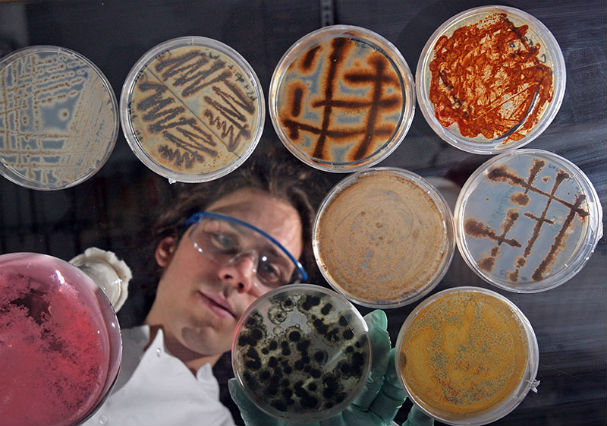
Gerald Lackner from the Leibniz Institute for Natural Product Research and Infection Biology looks at Petri dishes with antibiotic-producing bacteria called streptomycetes.
Credit: Jan-Peter Kasper/FSU
Top 5 NGOs for scientific research in 2018
These organizations are the most prolific in high-quality research.
13 August 2019

Jan-Peter Kasper/FSU
Gerald Lackner from the Leibniz Institute for Natural Product Research and Infection Biology looks at Petri dishes with antibiotic-producing bacteria called streptomycetes.
These institutions were the largest contributors to papers published in the 82 leading journals tracked by the Nature Index from the NGO/NPO sector in 2018.
Germany dominates, with three of the top five institutes based in Berlin, Munich, and Bonn.
The top five has remained unchanged since 2015, and for 2018, the Barcelona Institute of Science and Technology; Carnegie Institution for Science; National Center for Atmospheric Research; Salk Institute for Biological Studies; Perimeter Institute for Theoretical Physics round out the top 10.
The Max Planck Society is the most prolific of the lot, also ranking in the top five for the physical sciences, chemistry, life sciences and global institutes in the 2019 Nature Index Annual Tables.

1. Max Planck Society
Fractional count: 757.32 (-2.3%), Article count: 2,431
Named after the Nobel Prize-winning creator of quantum theory, this German powerhouse is an international team player, with some 74% of its co-authored papers produced with partners in another country.
It encompasses 84 institutes and more than 23,000 staff, with scientists accounting for 32% of employees.
In 2017, Max Planck Society's annual budget reached US$1.9 billion, most of which was contributed by the federal government. In addition to basic research, it takes credit for more than 4,000 inventions and 120 company spin-offs, including ProteoPlex, which develops protein analysis techniques.
In 2018, Max Planck Society researchers discovered evidence that the world’s oldest cave paintings were created by Neanderthals, not humans. The Science paper was mentioned by more than 200 news outlets and in more than 1,000 tweets.
2. Helmholtz Association of German Research Centres
Fractional count: 483.23 (-7.6%), Article count: 2,078
With more than 40,000 employees and an annual budget of €4.7 billion (approximately US$5.3 billion), the Helmholtz Association of German Research Centres has become the largest scientific organization in Germany since its founding in 1995.
It’s also ranked in the top 10 for Earth and environmental sciences, physical sciences, and global institutes for 2018.
In addition to producing high-quality science within its 19 research centres, Helmholtz has formed strong global ties. The institution has attracted roughly 10,000 visiting scientists and international staff from more than 30 countries.
Sören Wiesenfeldt, head of department research, says the institution’s large-scale facilities and infrastructure, from research vessels to particle accelerators, has created an environment where researchers can “shape, preserve and improve the long-term foundations of human life”.

3. Leibniz Association
Fractional count: 196.92 (2.1%), Article count: 782
Encompassing 95 non-university research institutes with around 20,000 staff in total, including 9,000 researchers and roughly 3,900 PhD students, Germany’s Leibniz Association is known for the breadth of research it undertakes, covering virtually all fields of academic research.
Leibniz Institutes are involved in roughly 4,900 international collaborations in 170 different countries. They collaborate intensively with universities – partnerships referred to as "Leibniz ScienceCampi" – and access an annual budget of more than €1.9 billion (approximately US$2.13 billion ).
The Leibniz Association has maintained its position as the third most prolific publisher of high-quality research, as tracked by the Nature Index, for four consecutive years.
It’s ranked 53rd in the 2019 Global Top 100 Annual Tables, and its highest ranking by category is 49th in the physical sciences.

4. Russian Academy of Sciences
Fractional count: 188.81 (3.4%), Article count: 745
Founded in Saint Petersburg on the order of Peter the Great and by Decree of the Senate in the 18th century, the Russian Academy of Sciences quickly became a powerhouse of scientific research and publication.
In 1925, it became the Academy of Sciences of the USSR, and in November 1991, was reconstituted as the Russian Academy of Sciences, and deemed the highest scientific institution in Russia.
Following decades of decline since its reconstitution, the academy has more recently been reinvigorated, with Russian President Vladimir Putin citing science and innovation as top priorities for the nation.
The academy, which includes more than 700 research organizations, has held fourth place in the Nature Index NGO/NPO rankings since 2015.
In 2018, the Russian Government allocated 170 billion roubles (approximately US$2.7 billion) for fundamental research and development – a 25% rise over 2017’s basic science budget. Between 2006 and 2016, the number of scientific papers produced in Russia more than doubled, and the country is now ranked 18th in the world in high-quality research output, as tracked by the Nature Index.

5. Scripps Research
Fractional count: 139.82 (-9.3%), Article: 282
One of the world’s largest private, non-profit biomedical research organizations, encompassing more than 200 laboratories with roughly 2,400 staff, including scientists, technicians, graduate students and administrative personnel, Scripps Research is known for its work in areas such as immunology, molecular and cellular biology, infectious diseases and synthetic vaccine development.
Headquartered in California with a sister facility in Florida, the organization was named the world’s most influential research institution in the 2017 Nature Innovation Index, based on its influence on patents (Lens score).
It now claims almost 1,100 United States patents, has more than 25 drug candidates in the pipeline, and is connected to more than 80 spin-off companies.
High-profile researchers include Kristian Andersen, who is developing new methods for tracking virus outbreaks and understanding how diseases like Zika and Ebola spread, and Kristin Baldwin, a neuroscience and stem cell researcher who discovered how a certain large block of DNA causes cellular abnormalities involved in the most common genomic risk factor for heart disease.
Read next:
